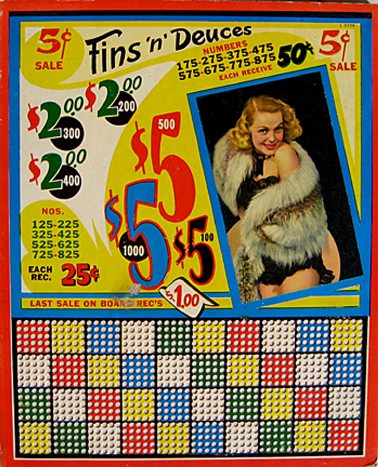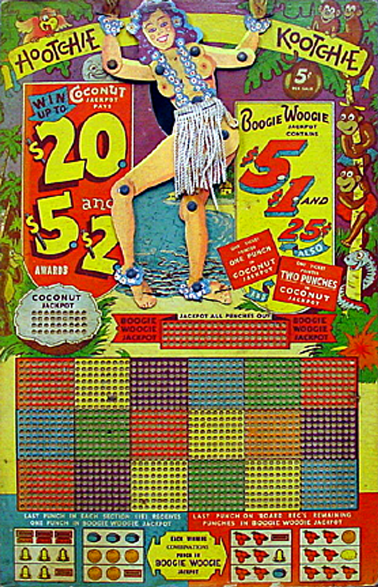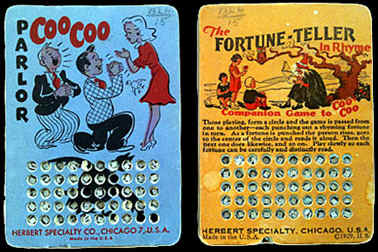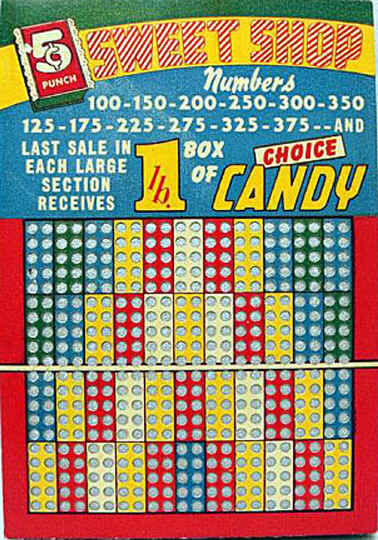|
Punch to Win by Bob Brooke
Punchboards were an early form of lottery game boards used in the 18th century. Though lotteries were as popular back then as they are today, they required a large number of players to be profitable. To enable one or several people to play, a local tavern owner would construct a game board out of wood eight inches square and half an inch thick, then drill small holes in it and fill them with small rolled pieces of paper on which he had written a number. He then covered the holes with paper. After a customer bought a chance at the punchboard, usually for a penny or a nickel, he would puncture one of the hole's paper covers with a nail and retrieve the piece of paper with a number on it. If the number matched those posted, the customer won a cash prize.
C.A. Brewer and C.C. Scannell of Chicago patented the modern punchboard in 1905. These new punchboards, made of cardboard, had paper covering both the front and back of each hole to help prevent operators from cheating. They came with a metal stylus and became popular purchases at drugstores, bars, and barbershops, much like today’s lottery tickets sold at convenience stores. Although punchboards had been around for many years, they had never been so available or so portable. Brewer and Scannell created their punchboards so that one customer could play a lottery, with no contribution necessary from anyone else. This enabled the punchboard's owner/operator to sell chances to one customer at a time, and to immediately tell how much he had won, without waiting for all the punchboard numbers to be sold.
The concept of the punchboard had been around for
many years before 1905. Many bar and pool hall owners making their own
punchboards, drilling a few holes in a wooden board, then stuffing
small pieces of rolled paper into each hole. Unfortunately, the
customer only had the punchboard owner’s word that there was a
winning number in at least one of the remaining non-punched holes, a
fact that often just wasn’t true. Too often the owner/maker of the
homemade punchboard would punch out the winning hole Many people soon realized these homemade punchboards were probably fraudulent, thus the popularity of punchboarding declined. It took the invention of punchboard manufacturing machines, which could cover both sides of the board with a sheet of undamaged paper, to convince customers to return to punchboard gambling. The mass-production of punchboards led to a general
standardization of shapes and a standardization of the themes that
helped identify different manufacturers' boards. Although most boards
were rectangular in shape, their themes were unique. Some of the
successful themes featured drawings of shapely pinups, and titles that
implied that certain boards offered big payoffs, such as Win u Ruck, Some punchboards had as many as 10,000 holes, and some as few as 25. Some paid out prizes instead of money, such as cigarettes, and some guaranteed that everyone was a winner. But they all had one thing in common—their calculated average gross profit or what the board's owner could expect as his profit when he sold all the holes and gave out all the prizes. Not bad, in an era when lunch cost 25 cents and a gallon of gas cost 10. Punchboard sales declined significantly after WWII,
as many states made them illegal. Many manufacturers attempted to
disguise the gambling nature of the boards by stating that prizes were
"for trade only" and not redeemable for cash. Cigarette,
cigar, and beer companies used punchboards as an advertising medium,
featuring packages of cigarettes or bottles of beer as prizes on their
punchboards instead of cash. While some of these boards were operated
as advertising gimmicks, most were still played for cash. The makers
of a few products were successful with punchboard advertising,
including Zippo lighters. Despite the millions of punchboards produced, it’s difficult for collectors to find non-punched or unusual punchboards because most were simply thrown away when their original owner felt the board would no longer sucker another coin from an unwitting player. Punchboard prices range from a couple of dollars
for a board with dog-eared edges and faded colors, up to several
hundred dollars for a non-punched board in pristine condition. As with
most collectibles, condition is important in a punch-board's cost. And
some punchboard Though there have been numerous lottery-type games invented over the years, none fired the imagination of gamblers and collectors like the punchboard. As an avid collector of a variety of antiques and collectibles for the last 20 years, Bob Brooke knows what he’s writing about. Besides writing about antiques, Brooke has also sold at flea markets and worked in an antique shop, so he knows the business side too. His articles have appeared in many antiques and consumer publications, including British Heritage, Antique Week, Southeastern Antiquing and Collecting Magazine, OldandSold.com, and many others. To read more of his work, visit his main website at www.bobbrooke.com or his specialty antiques site at http:// www.theantiquesalmanac.com
PHOTO CAPTIONS: (from top to bottom) For the price of a penny to two bits (25 cents), a player could take a chance to win up to $500 from a punchboard. Many punchboards had a theme, such as sports. Card games were another theme that was commonly used for punchboards. Some punchboards combined card games and Some of the successful themes featured drawings of shapely pinups. Punchboard manufacturers produced smaller versions to be used as parlor games. Prizes for some punchboards included other items besides cash and cigarettes, including tins of candy. |






